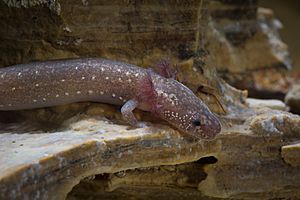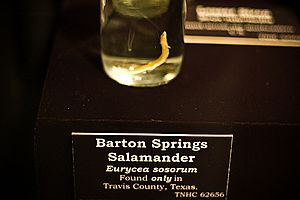Barton Springs salamander facts for kids
Quick facts for kids Barton Springs salamander |
|
|---|---|
 |
|
| Conservation status | |
| Scientific classification |
The Barton Springs salamander (Eurycea sosorum) is a special type of salamander. It is an endangered animal, meaning it's at risk of disappearing forever. This salamander is a "lungless" type, so it breathes through its skin and gills. It lives only in Texas, United States, which makes it endemic to that area.
These salamanders were first found in Barton Springs in Austin. Now, they are also known to live in nearby Travis and Hays Counties. Adult Barton Springs salamanders are about 6.4 centimetres (2.5 in) long. They have a mottled look, with colors ranging from dark purple to light yellow.
Contents
How the Environment Affects Them
Many amphibian species around the world are facing problems. This is partly due to climate change. Things like more UV radiation and changes in rainfall can harm them. Diseases like the chytrid fungus also cause issues.
However, for the Barton Springs salamander, local problems are a big threat. These include the destruction of their homes and pollution. These issues often come from cities growing and building on land near water. These changes can make the water dirty. They also affect the types of plants and animals living in rivers and water systems. It can be hard to find the exact source of pollution. This is because many things can interact and cause problems at the same time. But it's important to study these effects. This helps us protect this salamander and other species in the future.
Breathing Underwater
Dissolved oxygen (DO) is oxygen mixed in water. It needs to be at certain levels for aquatic life to be healthy. The U.S. Environmental Protection Agency sets rules for how much oxygen should be in the water.
If there isn't enough oxygen, it's called hypoxia. Low oxygen can harm baby salamanders as they grow. It can also make it harder for adult salamanders to breathe. When oxygen is low, salamanders might show certain signs. Their heart rate might go up. They might also move their mouths more or try to cool down their bodies. Their gills might also grow larger.
The Barton Springs salamander keeps its gills its whole life. This means it must get oxygen through its gills or skin. Scientists are still studying how they do this. One study found that these salamanders move more when oxygen levels are low. Scientists have two ideas why they do this:
- Areas with low and high oxygen might be close together. Moving helps the salamander find water with more oxygen.
- Moving helps water flow better around their skin and gills. This allows them to take in more oxygen.
What They Eat and How They Act
Scientists don't know a lot about the daily life of the Barton Springs salamander yet. It seems they mostly eat small aquatic crustaceans. These are tiny creatures that live in water. They might also eat other things, like earthworms.
Water plants are also very important for the salamander's home. When many plants were removed from Barton Springs, the salamander numbers dropped quickly. After programs helped restore the plants, their numbers went back up.
Where the Name Comes From
The second part of the salamander's scientific name, sosorum, is an acronym. It stands for "Save Our Springs Ordinance". This was a rule made by the City of Austin. Many people mistakenly think it refers to the SOS Alliance. This is a local group that works to protect nature. The "orum" part is a Latin ending.
Protecting the Salamander
Even though it lives in a city, the Barton Springs salamander was not officially named until 1993. In 1997, it was added to the federal List of Threatened and Endangered Species. This meant it was protected by law.
This protection caused a problem for the City of Austin. For 70 years, they had cleaned the Barton Springs Pool with bleach. But the salamander's listing stopped them from using bleach. So, in 1998, the City of Austin got a special permit. This permit allowed them to accidentally harm a few salamanders during pool cleaning. This permit lasts for 15 years.
As part of the deal, the City agreed to help the salamanders. They promised to use 10% of the money from pool entry fees for conservation. This money is used for research and to improve the salamander's home.



